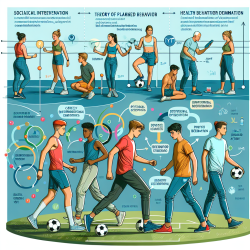Introduction
As practitioners dedicated to improving the lives of children, we are constantly seeking ways to apply research findings to our practice. The study titled "Gender-specific associations between involvement in team sport culture and Canadian adolescents’ substance-use behavior" offers critical insights into how team sports can influence substance use among adolescents. This blog post will explore the implications of this research and provide actionable strategies for practitioners to guide young athletes towards healthier choices.
Understanding the Research
The study analyzed data from the 2013-14 Health Behaviour in School Aged Children (HBSC) survey, focusing on Canadian adolescents. It found that team sports participation is associated with increased binge drinking and smokeless tobacco use, but decreased cannabis use and cigarette smoking in girls. The study also highlighted gender-specific differences, with boys facing higher risks when both socially and physically involved in sports, while girls were more at risk with high social involvement alone.
Implications for Practitioners
Understanding these associations allows practitioners to tailor interventions more effectively. Here are some strategies to consider:
- Education and Awareness: Educate parents, coaches, and athletes about the potential risks associated with team sports. Highlight the importance of a balanced approach to extracurricular activities.
- Diverse Engagement: Encourage participation in a variety of activities beyond sports to mitigate the risk of substance use. This can include arts, volunteering, and academic clubs.
- Mentorship Programs: Implement mentorship programs where older athletes guide younger ones, promoting positive behaviors and decision-making.
- Policy Development: Advocate for policies that limit the exposure of young athletes to substance use within sports environments, such as reducing alcohol-related marketing at sporting events.
Encouraging Further Research
While this study provides valuable insights, further research is needed to explore the mechanisms driving these associations and to develop targeted interventions. Practitioners can play a crucial role in this by participating in research initiatives and contributing their observations from the field.
Conclusion
By applying the findings of this research, practitioners can make informed decisions that promote healthier outcomes for young athletes. Encouraging a balanced approach to sports and extracurricular activities can help mitigate the risks of substance use and foster a supportive environment for adolescent development.
To read the original research paper, please follow this link: Gender-specific associations between involvement in team sport culture and Canadian adolescents’ substance-use behavior.










